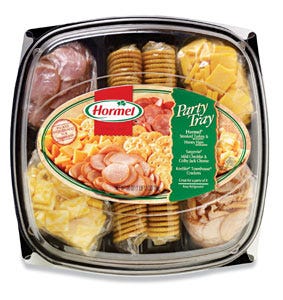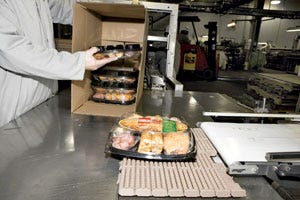September 12, 2014
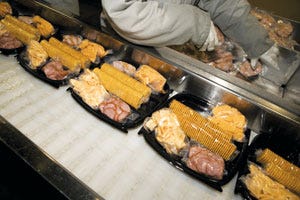
PDX1004hormel7
Hormel Foods, Austin, MN, has completed a six-month redesign project, which resulted in an updated look of its Hormel Party Trays, more sustainable package manufacturing and more efficient case-packing of the trays.Ongoing product evolution
Originally launched five years ago, Hormel's Party Tray product line includes a number of meats, cheese and cracker combination platters marketed to ease food preparation and presentation for special occasions. Since the trays were introduced, Hormel has expanded the product range to include individual-serve versions and large, supreme party trays, which add upscale items such as olives.
In addition to developing new component combinations for its Party Trays, Hormel also has recently re-evaluated the round tray package used for many of its snack trays.
Driving innovation
PDX1004hormel3 |
The previous package's large product label, above, didn't |
PDX1004hormel1 |
“The project began with Hormel's marketing group research about what our consumers wanted to see,” Hormel research and development scientist Chad Donicht recalls. “The charge from consumers was to come out with a fresher, cleaner and more sustainable package.
According to Holly M. Drennan, product manager for retail dry sausage and party trays at Hormel, consumers and retailers both indicated they wanted to see more of the meats, cheese and crackers in the party trays. Viewing of a tray's components was obscured by a large label and the lack of separation between the products.
“Our previous tray didn't really have any compartments, so the products would get mixed together,” Donicht remarks. “This is one of the things we found that consumers didn't want—maybe they didn't like certain type of a pepperoni, or they liked hard salami better.”
To develop this more sustainable package, Hormel evaluated packaging concepts from suppliers as well as its internal teams.
“Hormel can have multiple strategic suppliers in same category,” says Daniel Miller, Hormel packaging research and development manager. “For example, we have four strategic suppliers for corrugated boxes. Many times what we do is leverage these companies to see which one actually has the best idea.”
Materializing ideas
The packaging ideas that Hormel liked best didn't come from the packaging supplier that had been supplying the trays, so Hormel reevaluated which company would win that business.
“The company we were getting the trays from didn't have the best design at that time,” Donicht adds. “So we changed suppliers to another company that came up with better designs.”
The outside supplier, which Hormel declined to identify, was asked to join a cross-functional team comprising research and development, marketing, purchasing and operations for group brainstorming.
From ideas generated at this brainstorming session, the supplier used Dassault Systèmes SolidWorks software to develop 3D package renderings, which enabled Hormel to control upfront design and prototype costs.
After evaluating the 3D renderings, Hormel did commission about a dozen prototype trays for distribution testing. “Drop and vibration testing shows us how the locks are working, how the labels snap in, and if we are going to see any issues with the trays cracking,” Donicht remarks.
Shaping improvements
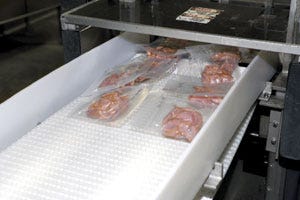
PDX1004hormel16
The resulting package is a square, two-piece snap tray with a base made of 24 mil RPET and a lid made from 20 mil RPET. Previous packaging was a round container with a base made from 30 mil PP and a lid made of 18 mil PET.The square shape offers sustainability benefits as early in the process as package manufacturing. “There's not as much scrap when they form the square tray [versus the previous round tray],” Donicht explains. “So there's a lot less regrind for them, which makes them much more efficient.”
The tray supplier also incorporated a new inset label function into the lid. This feature allows the package graphics to be snapped under the lid, eliminating the need for overwrap to hold the label to the tray.
Packing without preservatives
PDX1004hormel21 |
Workers put the finishing touches on packed party trays, top, as they travel on an in-house manufactured conveyor. Because the package shape was changed from round to square, they now fit more tightly into each corrugated case. |
PDX1004hormel9 |
Each tray contains individually packed and coded packs of crackers, meats and cheese.
Crackers and cheese arrive at Hormel's facility prepacked. Copacker Reichel Foods, Rochester, MN, packs the dry meats, such as sausages.
The wet meats, e.g., ham and turkey, are packed at Osceola Foods Inc., which is owned by Hormel.
The Osceola Foods plant uses high-pressure processing (HPP) to eliminate the need for chemical preservatives for its wet meats. HPP is a USDA–approved process that utilizes intense cold-water pressure to protect against harmful bacteria without affecting a food product's taste, texture, apperance or nutritional value.
“Hormel, a number of years ago, implemented a process we call high-pressure pasteurization,” Miller explains. “We take the prepackaged meats as they come off of a Multivac vertical form/fill/sealers and place them into a carrier. They then go into a high-pressure pasteurization vessel that exerts around 86,000 lb/sq-in. of pressure. It's like being down at the bottom of the sea.
“It's part of the story of what makes Hormel's product taste a lot better than some of the other competitive product in the marketplace,” he adds.
Tray assembly, case packing
The tray bases travel on in-house manufactured conveyors as line workers hand place the individually packed components. The lids with the in-laid product branding cards are snapped onto the base.
Tamper-evident tape is applied to two sides of each tray by a custom applicator, which was manufactured by a small supplier recommended by xpedx. An automatic labeler applies nutritional labels to every tray. Each tray is dated-coded before it is manually packed into a case. A 3M taper top- and bottom-seals filled cases before they are manually palletized. A Lantech stretchwrapper secures the pallets before transit.
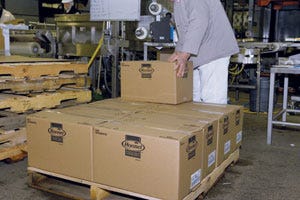
PDX1004hormel6
Savings by the pound

PDX1004hormel6
The updated packaging is expected to result in corrugated material savings of more than 174,000 lb/year and shrink-wrap savings of 100,000 lb/year. Each finished pallet contains three more filled cases, reducing 71 truckloads required to transport the same amount of product annually.
More information is available: |
3M, 651/733-1110 www.3m.com/packaging |
Dassault Systèmes SolidWorks Corp., 800/693-9000.www.solidworks.com |
Lantech, 800/866-0322. www.lantech.com |
Multivac Inc., 816/891-0555. www.multivac.com |
xpedx, 513-965-2900. www.xpedx.com |
About the Author(s)
You May Also Like

